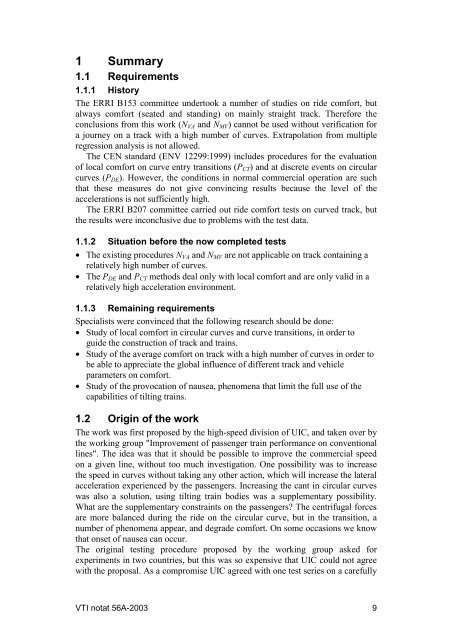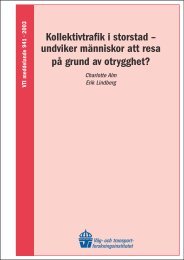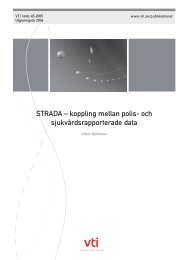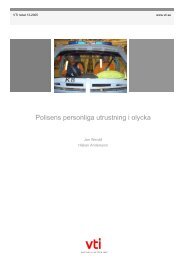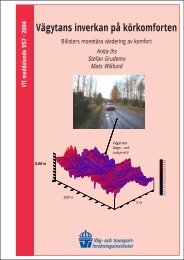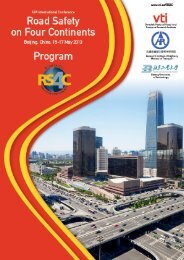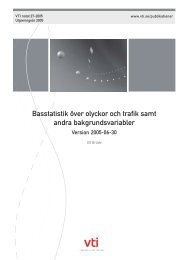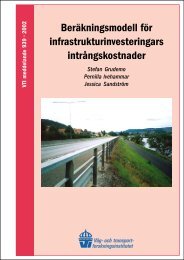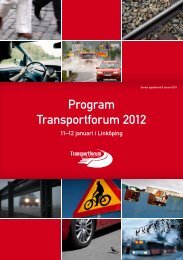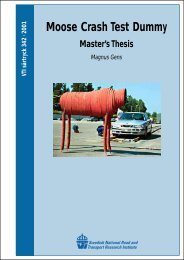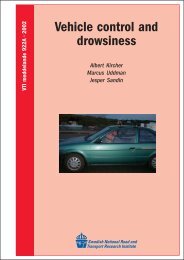UIC comfort tests - VTI
UIC comfort tests - VTI
UIC comfort tests - VTI
You also want an ePaper? Increase the reach of your titles
YUMPU automatically turns print PDFs into web optimized ePapers that Google loves.
1 Summary1.1 Requirements1.1.1 HistoryThe ERRI B153 committee undertook a number of studies on ride <strong>comfort</strong>, butalways <strong>comfort</strong> (seated and standing) on mainly straight track. Therefore theconclusions from this work (N VA and N MV ) cannot be used without verification fora journey on a track with a high number of curves. Extrapolation from multipleregression analysis is not allowed.The CEN standard (ENV 12299:1999) includes procedures for the evaluationof local <strong>comfort</strong> on curve entry transitions (P CT ) and at discrete events on circularcurves (P DE ). However, the conditions in normal commercial operation are suchthat these measures do not give convincing results because the level of theaccelerations is not sufficiently high.The ERRI B207 committee carried out ride <strong>comfort</strong> <strong>tests</strong> on curved track, butthe results were inconclusive due to problems with the test data.1.1.2 Situation before the now completed <strong>tests</strong>• The existing procedures N VA and N MV are not applicable on track containing arelatively high number of curves.• The P DE and P CT methods deal only with local <strong>comfort</strong> and are only valid in arelatively high acceleration environment.1.1.3 Remaining requirementsSpecialists were convinced that the following research should be done:• Study of local <strong>comfort</strong> in circular curves and curve transitions, in order toguide the construction of track and trains.• Study of the average <strong>comfort</strong> on track with a high number of curves in order tobe able to appreciate the global influence of different track and vehicleparameters on <strong>comfort</strong>.• Study of the provocation of nausea, phenomena that limit the full use of thecapabilities of tilting trains.1.2 Origin of the workThe work was first proposed by the high-speed division of <strong>UIC</strong>, and taken over bythe working group "Improvement of passenger train performance on conventionallines". The idea was that it should be possible to improve the commercial speedon a given line, without too much investigation. One possibility was to increasethe speed in curves without taking any other action, which will increase the lateralacceleration experienced by the passengers. Increasing the cant in circular curveswas also a solution, using tilting train bodies was a supplementary possibility.What are the supplementary constraints on the passengers? The centrifugal forcesare more balanced during the ride on the circular curve, but in the transition, anumber of phenomena appear, and degrade <strong>comfort</strong>. On some occasions we knowthat onset of nausea can occur.The original testing procedure proposed by the working group asked forexperiments in two countries, but this was so expensive that <strong>UIC</strong> could not agreewith the proposal. As a compromise <strong>UIC</strong> agreed with one test series on a carefully<strong>VTI</strong> notat 56A-2003 9


